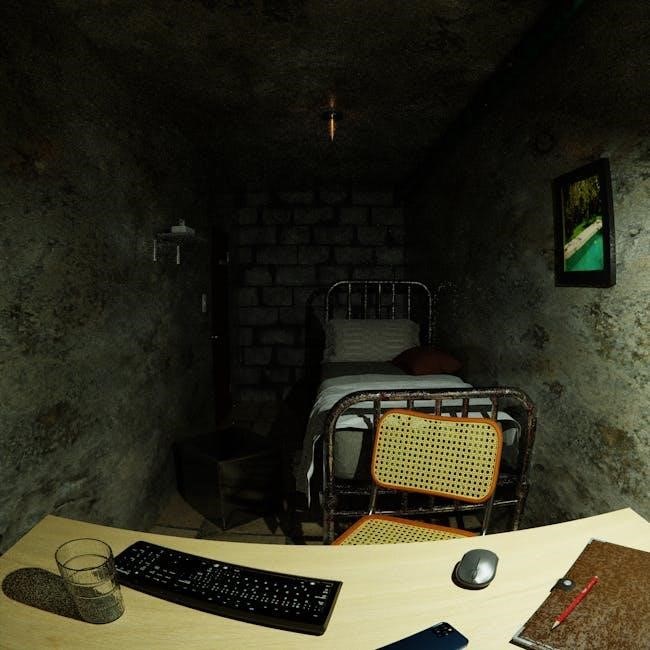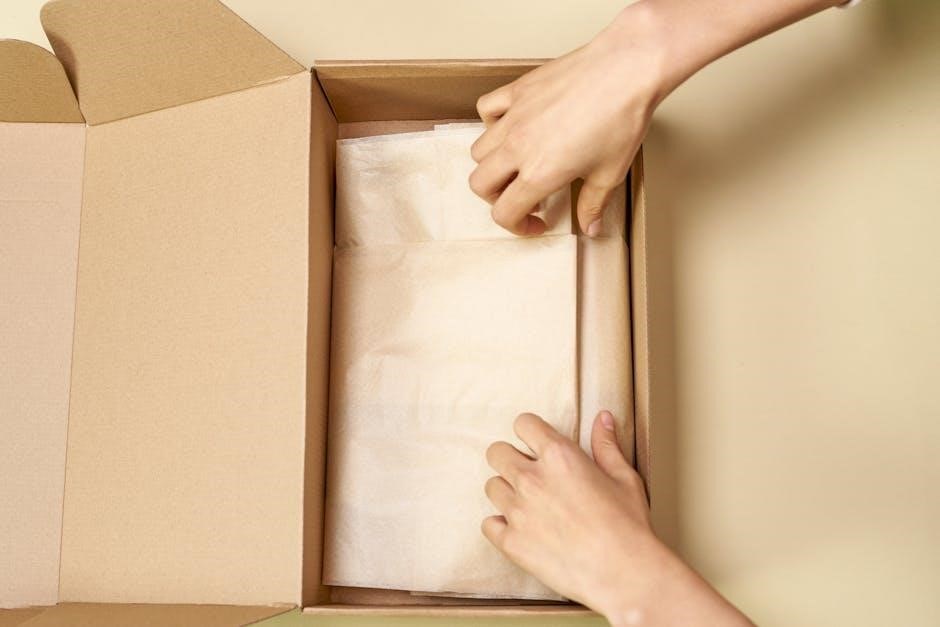
chicco kidfit manual
The Chicco KidFit Manual guides users through safe installation‚ adjustment‚ and maintenance of the booster seat‚ ensuring proper fit and protection for children from 30 to 110 pounds.
1.1 Overview of the Chicco KidFit Booster Seat
The Chicco KidFit Booster Seat is a versatile and safe solution for children transitioning from forward-facing car seats. Designed for kids weighing 30 to 110 pounds‚ it offers two modes: high-back and backless. The seat features an adjustable headrest‚ shoulder belt guides‚ and LATCH connectors for secure installation. Its energy-absorbing foam provides enhanced side-impact protection‚ while the contoured design ensures comfort. The KidFit is ideal for growing children‚ adapting to their needs as they progress through different stages of development.
1.2 Importance of Reading the Manual
Reading the Chicco KidFit Manual is essential for ensuring the booster seat is used correctly and safely. It provides detailed instructions for installation‚ adjustment‚ and maintenance‚ helping parents meet safety standards. The manual outlines weight and height limits‚ proper belt routing‚ and how to secure the seat using the LATCH system. Understanding these guidelines ensures optimal protection for your child. Additionally‚ the manual addresses common issues and offers troubleshooting tips‚ helping you maximize the seat’s effectiveness and longevity. Taking the time to read it thoroughly is crucial for your child’s safety and comfort.
1.3 Key Features of the Chicco KidFit
The Chicco KidFit boasts an array of innovative features designed for safety and comfort. Its DuoGuard system offers head and torso protection‚ while energy-absorbing foam enhances side-impact safety. The booster seat is versatile‚ supporting both high-back and backless modes‚ and accommodates children from 30 to 110 pounds. Adjustable headrests and shoulder belt guides ensure a proper fit‚ and the LATCH connectors provide secure installation. Removable fabric covers and cup holders add convenience‚ making it a practical choice for growing children. These features combine to create a reliable and adaptable booster seat for years of safe use.

Product Specifications
The Chicco KidFit accommodates children from 30 to 110 pounds and 38 to 57 inches tall‚ featuring energy-absorbing foam and meeting rigorous safety standards for reliable protection.
2.1 Weight and Height Limits
The Chicco KidFit accommodates children from 30 to 110 pounds and 38 to 57 inches tall in high-back mode‚ transitioning to backless for taller or heavier kids. The KidFit Plus supports 40-110 pounds and 38-57 inches‚ ensuring a safe fit as children grow. Always verify your child’s measurements against these limits to ensure proper protection and compliance with safety standards. Refer to the manual for precise guidelines on weight and height restrictions for both modes of use.
2.2 Dimensions and Adjustability
The Chicco KidFit measures 20.5 x 18 x 25 inches‚ designed to fit various vehicle sizes. Its adjustable headrest offers 10 positions‚ ensuring proper shoulder belt alignment. The seat’s width and depth adapt to growing children‚ while the contoured ErgoBoost base provides leg support. Integrated cup holders add convenience. The booster’s compact design allows easy repositioning between vehicles‚ making it versatile for families. Adjustability ensures a snug‚ comfortable fit‚ promoting safety and comfort as children grow.
2.3 Materials and Safety Standards
The Chicco KidFit is constructed with high-quality‚ durable materials designed for long-lasting safety and comfort. It meets or exceeds all federal safety standards for booster seats. The seat features energy-absorbing foam for enhanced side-impact protection and a sturdy frame for structural integrity. The DuoGuard system provides dual-layer protection for the head and torso. Rigorous testing ensures the seat performs well in crash scenarios‚ offering parents peace of mind. The materials are also easy to clean and maintain‚ ensuring hygiene and durability over time.

Installation and Setup
The Chicco KidFit manual provides clear instructions for installation using LATCH or vehicle belts‚ ensuring a secure fit. Adjust the headrest and guides for proper positioning.
3.1 LATCH System Installation
The Chicco KidFit manual details the LATCH system installation process. Release the LATCH adjustment strap and pull the release handle to extend the connectors. Attach them to the vehicle’s lower anchors‚ then tighten the strap by pulling firmly to secure the booster seat. Ensure the seat is snug against the vehicle’s seat back for optimal stability. Always verify proper installation by checking the seat’s firmness and alignment. Follow the manual’s guidance to ensure a safe and correct LATCH system setup for your child’s protection;

3.2 Vehicle Belt Routing and Securement
For proper vehicle belt routing‚ position the lap belt under the first armrest across the child’s thighs and the shoulder belt under the second armrest. Ensure the shoulder belt lies across the chest and the lap belt over the thighs. Buckle the seat belt securely‚ verifying a snug fit. The Chicco KidFit manual emphasizes correct belt placement to maximize safety and comfort. Always check the manual for specific guidance on routing and securing the vehicle belt for your child’s booster seat.
3.3 Adjusting the Headrest and Shoulder Belt Guides
To adjust the headrest‚ squeeze the height adjuster lever at the back while holding the seat firmly. Raise or lower until it clicks into position‚ ensuring the shoulder belt guide aligns at or just above the child’s shoulder. This ensures proper belt placement across the chest and shoulders. The Chicco KidFit manual highlights the importance of correct headrest and shoulder belt guide adjustment for optimal safety and comfort during travel.

Safety Features and Technologies
The Chicco KidFit features advanced safety technologies‚ including DuoGuard head and torso protection‚ energy-absorbing foam for side impacts‚ and secure belt routing with LATCH connectors for optimal protection.
4.1 DuoGuard Head and Torso Protection
The DuoGuard system offers enhanced head and torso protection with 10 adjustable positions‚ ensuring a customized fit for growing children. It combines a sturdy headrest with energy-absorbing foam to cushion impacts‚ providing superior safety in side collisions. The adjustable shoulder belt guides align the vehicle’s seat belt correctly across the child’s chest‚ preventing misuse. This innovative design prioritizes both comfort and protection‚ making it a standout feature of the Chicco KidFit booster seat.
4.2 Energy-Absorbing Foam for Side Impact
The Chicco KidFit features energy-absorbing foam designed to reduce the impact of side collisions. This foam is strategically placed in the seat’s sides to cushion the child’s head and torso‚ distributing crash forces away from the body. It works alongside the DuoGuard system to enhance protection and ensure a safer ride. The foam’s lightweight yet durable construction maintains comfort while meeting rigorous safety standards‚ providing peace of mind for parents and optimal protection for children during unexpected side impacts.
4.3 Secure Belt Routing and LATCH Connectors
The Chicco KidFit features secure belt routing and LATCH connectors for a stable installation. The LATCH system attaches directly to the vehicle’s lower anchors‚ ensuring a snug fit without relying on the seat belt. The connectors are easy to use‚ with a simple release handle and adjustment strap to tighten the seat in place. Additionally‚ the belt routing guides help position the vehicle’s shoulder and lap belts correctly across the child’s body‚ ensuring optimal safety and proper restraint in the event of sudden stops or collisions.

Maintenance and Cleaning
Regularly clean the Chicco KidFit by removing fabric covers and hand washing them. Reattach foam pads securely after washing. Wipe foam and plastic parts with mild soap and water‚ then dry thoroughly.
5.1 Removing and Washing Fabric Covers
To maintain the Chicco KidFit‚ start by removing the cup holders; Flip the booster seat bottom over and unhook the elastic loops. Gently pull the fabric covers away from the frame. Machine wash the covers in cold water using a mild detergent. Avoid bleach or harsh chemicals. Allow the fabric to air dry completely before reattaching. Ensure the foam pad is securely inserted back into the fabric seat bottom before reinstalling onto the seat frame. Proper cleaning ensures hygiene and longevity of the booster seat.
5.2 Cleaning the Foam and Plastic Parts
Gently clean the foam and plastic parts of the Chicco KidFit using a soft‚ damp cloth. Avoid submerging the foam in water or using harsh chemicals‚ as this may damage the material. For stubborn stains‚ mix a small amount of mild soap with warm water and apply it sparingly. Wipe thoroughly with a clean‚ damp cloth to remove any soap residue. Allow the parts to air dry completely before reassembling the booster seat. Regular cleaning ensures the longevity and safety of the seat.
5.3 Storage and Transportation Guidelines
Store the Chicco KidFit in a dry‚ cool place away from direct sunlight and extreme temperatures. Avoid leaving the booster seat in a hot vehicle for extended periods. When transporting‚ ensure the seat is securely fastened to prevent movement. Remove any loose accessories and protect the seat from potential damage during travel. Always follow the manufacturer’s instructions for storage and transportation to maintain the seat’s safety and durability. Proper care ensures the booster seat remains in optimal condition for your child’s protection.

Troubleshooting Common Issues
Address common issues like seat belt fit‚ LATCH malfunctions‚ or fabric damage by adjusting the headrest‚ consulting the vehicle manual‚ or inspecting for wear and tear.
6.1 Seat Belt Fit and Adjustment Problems
If the seat belt doesn’t fit properly‚ ensure the shoulder belt lies across the child’s chest and the lap belt is snug over the thighs. Adjust the headrest height by squeezing the lever and positioning the shoulder belt guide at or above the child’s shoulder. If the belt is too loose or tight‚ check the booster seat’s alignment and snugness against the vehicle seat. Consult the vehicle’s manual for belt routing guidance or contact a certified technician for assistance.
6.2 LATCH System Malfunction
If the LATCH system malfunctions‚ ensure the connectors are securely attached to the vehicle’s lower anchors. Release the adjustment strap and pull firmly on the LATCH release handle to extend the connectors. If the seat isn’t snug‚ push the seat back while tightening the adjustment strap. If issues persist‚ try using the vehicle’s seat belt for installation instead. Always refer to the manual for proper LATCH system operation or contact a certified technician for further assistance.
6.3 Fabric or Foam Damage
If fabric or foam damage occurs‚ inspect the affected areas for tears or compression. For fabric‚ remove covers and wash as instructed in the manual. Avoid harsh chemicals. For foam damage‚ clean gently with a damp cloth. If damage compromises safety‚ contact Chicco Customer Service for replacement parts. Proper cleaning and storage can prevent such issues. Always follow manual guidelines to maintain the seat’s integrity and ensure your child’s safety. Regular inspections are crucial for identifying wear and tear early.

Customer Support and Resources
Chicco offers dedicated customer support at 1-877-424-4226. Digital manuals are available online‚ and certified technicians can assist with installations for optimal safety and convenience.
7.1 Contacting Chicco Customer Service
For assistance with the Chicco KidFit‚ contact customer service at 1-877-424-4226. Have the model and serial number ready‚ located on the label at the bottom of the booster seat. Representatives are available to address installation questions‚ troubleshooting‚ or general inquiries. This direct support ensures users can resolve issues promptly‚ maintaining safety and convenience for their child. The service team provides expert guidance‚ helping parents use the KidFit correctly and effectively.
7.2 Accessing the Digital Manual
The Chicco KidFit digital manual is available for free online‚ providing comprehensive guidance on setup‚ maintenance‚ and troubleshooting. Users can download the PDF manual from Chicco’s official website or platforms like Amazon. The manual covers detailed instructions for installation‚ adjusting features‚ and safety precautions. It also includes diagrams and step-by-step guides to ensure proper use. Accessing the digital manual is convenient‚ allowing parents to reference it anytime for optimal use of the booster seat. The manual is available in multiple languages‚ including English‚ for widespread accessibility;
7.3 Finding Certified Installation Technicians
For assistance with installing the Chicco KidFit‚ parents can contact certified technicians through Chicco Customer Service at 1-877-424-4226. The manual recommends consulting a certified child passenger safety technician for complex installations. Additionally‚ local car seat inspection stations or community safety programs often provide free or low-cost installation help. Always ensure technicians are certified to guarantee proper and safe installation of the booster seat‚ adhering to both manufacturer and vehicle guidelines.

Comparing Chicco KidFit Models
The Chicco KidFit lineup includes the standard KidFit‚ KidFit Plus‚ KidFit Zip‚ and KidFit ClearTex Plus‚ each offering unique features like weight capacity‚ adjustability‚ and advanced safety technologies.
8.1 KidFit vs. KidFit Plus
The KidFit and KidFit Plus differ in features and functionality. The standard KidFit offers a versatile booster seat with adjustable height and secure belt routing‚ suitable for children from 30 to 110 pounds. The KidFit Plus enhances this with additional features like energy-absorbing foam for side impact protection and a contoured design for better comfort. Both models prioritize safety and adaptability‚ but the Plus version provides extra layers of protection and convenience‚ making it a premium choice for parents seeking advanced safety features.
8.2 KidFit Zip vs. KidFit ClearTex Plus
The KidFit Zip and KidFit ClearTex Plus are both booster seats designed for comfort and safety‚ but they differ in design and features. The KidFit Zip is known for its portability and compact design‚ making it easy to transfer between vehicles. The ClearTex Plus offers enhanced comfort with its contoured ErgoBoost cushioning and 10-position DuoGuard head and torso protection. Both models prioritize safety‚ but the ClearTex Plus provides additional comfort and advanced protective features‚ catering to parents seeking a more premium option for their growing children.
8.3 Key Differences in Features and Benefits
The Chicco KidFit models vary in features and benefits‚ catering to different needs. The KidFit Zip offers a lightweight‚ portable design with easy-transfer technology‚ while the KidFit ClearTex Plus provides advanced comfort with its ErgoBoost cushioning. The KidFit Plus includes additional storage options like cup holders and a snack console. Each model prioritizes safety with DuoGuard protection and energy-absorbing foam but differs in convenience and comfort features‚ allowing parents to choose based on their lifestyle and child’s preferences.

Frequently Asked Questions
Is the Chicco KidFit manual available in English? Yes‚ it is. How do I ensure proper seat belt fit? Follow the manual’s guidance for secure routing and adjustment.
9.1 Can the KidFit Be Used in Different Vehicles?
The Chicco KidFit is designed to be compatible with most vehicles equipped with a 3-point seat belt system or LATCH connectors. Always ensure your vehicle’s seat belt or LATCH system is compatible before use. For optimal safety‚ refer to your vehicle’s owner’s manual and the KidFit manual for specific installation guidelines. If unsure‚ consult a certified child passenger safety technician to confirm proper fit and installation in your vehicle. This ensures your child’s safety across different vehicles.
9.2 How Do I Know When to Switch to Backless Mode?
The transition to backless mode is recommended when your child’s shoulders exceed the height of the KidFit’s high-back portion. Typically‚ this occurs when the child is around 40 pounds or taller than 38 inches. Always consult the Chicco KidFit manual for specific guidelines‚ as it provides detailed instructions based on weight and height limits. Ensure the vehicle seat belt fits properly across the chest and thighs in backless mode for optimal safety and comfort. Proper fit is crucial to ensure effective protection.
9.3 Is the KidFit Compatible with All Vehicle Seat Belts?
The Chicco KidFit is designed to work with most vehicle seat belts‚ but compatibility may vary. It is optimized for use with 3-point seat belts‚ which are standard in most modern vehicles. However‚ certain vehicle seat belt configurations or older models may not be fully compatible. Always consult your vehicle’s owner’s manual to ensure proper fit and function. If unsure‚ contact a certified child passenger safety technician for assistance. Proper belt routing and fit are essential for safe use.
The Chicco KidFit Manual provides essential guidance for safe and effective use‚ ensuring your child’s protection with features like DuoGuard and energy-absorbing foam. Stay informed and follow updates for optimal safety.
10.1 Final Tips for Safe and Effective Use
Always follow the Chicco KidFit Manual for proper installation and adjustment. Ensure the seat belt is correctly routed and the booster is snug against the vehicle seat. Regularly check the fit of the shoulder and lap belts to accommodate your child’s growth. Clean and maintain the seat as instructed to preserve its safety features. Stay updated on any product recalls or updates from Chicco. Refer to your vehicle’s manual for compatibility and installation tips. Prioritize your child’s safety by adhering to all guidelines.
10.2 Encouraging Proper Car Seat Habits
Teach your child to stay seated and buckled during trips. Ensure the shoulder belt crosses their chest and the lap belt rests on their thighs. Avoid bulky clothing that could interfere with the seat belt fit. Regularly inspect the booster seat for proper positioning and tightness. Encourage your child to report any discomfort or issues with the seat. Make car safety a routine part of travel‚ emphasizing its importance for their protection. Consistency and awareness will help build lifelong safe habits.
10.3 Staying Informed About Product Updates
Regularly check the Chicco KidFit manual and official website for updates on safety standards‚ recalls‚ or new features. Subscribe to Chicco newsletters or follow their social media for notifications. Contact customer service for any concerns or clarifications. Staying informed ensures you have the latest information to maintain your child’s safety and optimize the booster seat’s performance. Visit Chicco’s official website for the most up-to-date resources and guidelines.